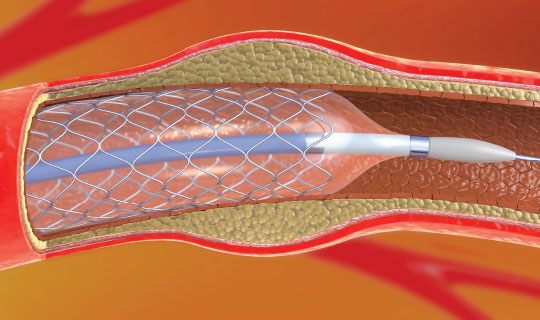Advanced technology and minimally invasive procedures have improved cardiac care for patients at Clara Maass Medical Center.
Forty-five years ago, a revolutionary concept allowed cardiologists to “travel” inside a person’s body to treat coronary artery disease (CAD) without the need for surgery. For the first time, they could insert a catheter into a blood vessel and widen the vessel with a balloon to improve the blood flow to the heart. In the 1990s, stents (small metal mesh tubes) were added to the technique. These stents were implanted in the heart vessels to ensure that they would stay open.
The technique became known as percutaneous (meaning “through the skin”) coronary intervention, or PCI. It’s now standard treatment for CAD and other cardiovascular conditions, performed in cardiac catheterization (cath) labs in hospitals. Advances in technique as well as technology have helped PCI deliver ever-better and more comprehensive care for cardiac patients.

“The cath labs of today have evolved from being purely diagnostic to combining both diagnosis and treatment,” says interventional cardiologist Elie Chakhtoura, MD, Director of the Cardiac Catheterization Laboratory at Clara Maass Medical Center (CMMC) and a member of RWJBarnabas Health Medical Group.
PCI Evolves
In PCI’s earliest days, interventional cardiologists performed the procedure with a transfemoral approach. They inserted a catheter into a puncture in the groin to reach the femoral artery—the main blood vessel supplying blood to the lower body—and then guided that catheter up into the vessel where the blockage was located.
The earliest catheters were relatively large in diameter (about 3 millimeters). “That led to higher rates of complications,” Dr. Chakhtoura recalls. By the early 2000s, smaller catheters (about 2 millimeters in diameter) helped to lessen the risk of bleeding after PCI. As technology evolved, newer stents, known as “drug-eluting,” were developed to release a medication that helps prevent scar tissue from growing into the repaired artery and also reduces the risk for blood clotting.
“Over the past few years, drug-eluting stents have become thinner, allowing for a better stent delivery and less trauma and inflammation in the coronary arteries,” Dr. Chakhtoura says. “This also allows patients to be on prescription blood thinners—a combination of aspirin and clopidogrel or ticagrelor—for a shorter time, sometimes for just one month, and then continue with aspirin alone thereafter.”
A Clearer View
As PCI treatments advanced through the decades, so too did diagnostics. Traditional angiography imaging gave interventional cardiologists a two-dimensional picture of a three-dimensional artery. “That meant we had to essentially estimate how severe a patient’s stenosis [narrowing of the arteries] was,” Dr. Chakhtoura says.
Today’s more sophisticated angiography, invasive imaging and flow evaluation technology give providers a better way to evaluate coronary blockages in the lab. Interventional cardiologists now use a specialized wire to measure coronary blood flow across a blockage, or introduce an ultrasound catheter that gives them a better detailed image of the vessel.
“This gives us a much better functional and anatomical understanding of the blockage, helping us determine whether we need to begin treatment and which type of treatment will be most beneficial for each patient,” Dr. Chakhtoura says.
Access Through The Wrist
The use of smaller catheters during PCI has led to the latest advance in treatment: a transradial approach, during which a physician inserts a catheter in the wrist instead of the groin, and then guides it to the affected vessel.
Research shows that the transradial approach, when compared to transfemoral, leads to less bleeding, fewer complications and better survival in patients presenting acutely with chest pain and heart attacks. Accessing a blocked artery through the wrist also leads to less discomfort for patients, earlier mobility (no to minimal bed rest) after the procedure and shorter hospital stays. As a result, transradial is now the standard of care for both coronary angiography and PCI.
“Almost anyone with a good blood supply to their hands is a candidate,” says Dr. Chakhtoura, who has used the transradial approach since 2012 and estimates he currently uses it in 75 to 80 percent of all PCI cases. “We’ve seen extremely beneficial results across the spectrum from low- to high-risk patients.”
Choosing a Cath Lab
The Cardiac Catheterization Laboratory at CMMC was part of a national study comparing PCI results at hospitals without on-site cardiac surgery with hospitals that offered open heart surgery. The results, published in The New England Journal of Medicine, showed that sites like CMMC without on-site cardiac surgery had slightly better mortality rates and fewer adverse cardiac events than those with on-site heart surgery.
“While those results weren’t statistically significant, they showed a trend that community hospitals like Clara Maass deliver as high a level of care as larger centers,” Dr. Chakhtoura says.
The Cath Lab at CMMC includes an experienced team of interventional cardiologists, technicians and nurses, along with the latest technology. CMMC is also an evaluation and referral center for structural heart disease, giving patients with heart valve problems access to leading-edge valve repair and replacement options—such as transcatheter aortic valve replacement and transcatheter mitral valve replacement such as the MitraClip— offered by their same physicians at Cooperman Barnabas Medical Center, which is also part of the RWJBarnabas Health system.
“The best news about PCI’s evolution is that it’s not a one-size-fits-all procedure— it can be customized to the patient’s needs,” Dr. Chakhtoura says. “We’re proud to offer patients a medical center that will deliver the fastest and safest cardiac care with the least amount of risk.”
Whoever your heart beats for, our hearts beat for you. Connect with a top cardiovascular specialist at Clara Maass Medical Center today.
